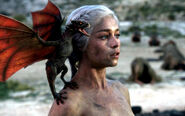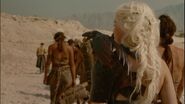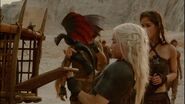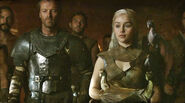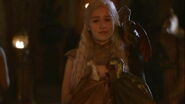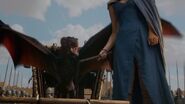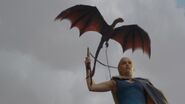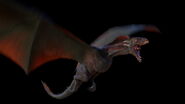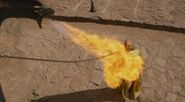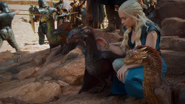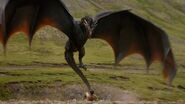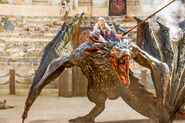Tag: sourceedit |
No edit summary Tag: sourceedit |
||
| (16 intermediate revisions by 4 users not shown) | |||
| Line 6: | Line 6: | ||
| Type= Reptile, magical |
| Type= Reptile, magical |
||
| Diet=Obligate carnivore |
| Diet=Obligate carnivore |
||
| − | | Status= Extinct from |
+ | | Status= Extinct from c. 150 - 298 AL, <br>now reborn |
| Habitat = Preferably volcanic mountains |
| Habitat = Preferably volcanic mountains |
||
| Range= [[Slaver's Bay]] (currently)<br>[[Valyrian Freehold]], [[Essos]] (formerly)<br>worldwide (formerly) |
| Range= [[Slaver's Bay]] (currently)<br>[[Valyrian Freehold]], [[Essos]] (formerly)<br>worldwide (formerly) |
||
| Line 20: | Line 20: | ||
==Biology== |
==Biology== |
||
| − | === |
+ | ===Overview=== |
[[File:Drogon, Viserion and Rhaegal 2x10.png|300px|thumb|Dragons have different color patterns.]] |
[[File:Drogon, Viserion and Rhaegal 2x10.png|300px|thumb|Dragons have different color patterns.]] |
||
Dragons have long serpentine bodies, with proportionately long necks and tails. Their bodies have four limbs: two short back legs and two large wings as forelimbs, a body-plan similar to a bat. In later generations, after the dragons went extinct, physical descriptions of dragons became so confused in memory that artwork sometimes depicted them as having ''six'' limbs - two wings growing out of their backs in addition to four legs - but this is inaccurate. The teeth and claws of adult dragons are as long and sharp as swords. |
Dragons have long serpentine bodies, with proportionately long necks and tails. Their bodies have four limbs: two short back legs and two large wings as forelimbs, a body-plan similar to a bat. In later generations, after the dragons went extinct, physical descriptions of dragons became so confused in memory that artwork sometimes depicted them as having ''six'' limbs - two wings growing out of their backs in addition to four legs - but this is inaccurate. The teeth and claws of adult dragons are as long and sharp as swords. |
||
| Line 35: | Line 35: | ||
* Cream with gold markings |
* Cream with gold markings |
||
| − | === |
+ | ===Fire-breath=== |
[[File:Dragon_Fire_Toasty.jpg|thumb|Dragon fire melts just about everything.]][[File:Dragon's_fire-spitting_organ.jpg|thumb|113px|Small tubes in Drogon's mouth showing where they spit fire from.]] |
[[File:Dragon_Fire_Toasty.jpg|thumb|Dragon fire melts just about everything.]][[File:Dragon's_fire-spitting_organ.jpg|thumb|113px|Small tubes in Drogon's mouth showing where they spit fire from.]] |
||
Probably the most famous attribute of dragons is their ability to breathe fire. Dragonflame can turn flesh to ash, melt steel, and crack stone. Older dragons can produce more intense flame for longer durations. Dragons seem to produce their fire-breath by expelling chemicals out of two tubes in the back of their throats: when these volatile substances combine, they undergo an intense reaction which bursts into a directed jet of fire. The bodies of dragons are also very resistant to fire, particularly their own flames, which don't even damage their own mouths as they expel them. Some believe that in many ways dragons ''are'' fire, fire given form as flesh: it is said that "fire cannot kill a dragon". |
Probably the most famous attribute of dragons is their ability to breathe fire. Dragonflame can turn flesh to ash, melt steel, and crack stone. Older dragons can produce more intense flame for longer durations. Dragons seem to produce their fire-breath by expelling chemicals out of two tubes in the back of their throats: when these volatile substances combine, they undergo an intense reaction which bursts into a directed jet of fire. The bodies of dragons are also very resistant to fire, particularly their own flames, which don't even damage their own mouths as they expel them. Some believe that in many ways dragons ''are'' fire, fire given form as flesh: it is said that "fire cannot kill a dragon". |
||
| − | === |
+ | ===Reproduction and Maturation=== |
Like most reptiles, dragons lay clutches of eggs. Dragon eggs are roughly the size of a human child's head, and as heavy as stone, so they need to be carried with two hands. The outer shell is covered in scales, with vastly different color patterns between eggs, usually matching the color of the dragon inside. Dragon eggs are notoriously difficult to hatch, though they can maintain the spark of life inside of them for decades if not centuries. The secret key to hatching the eggs seems to involve some form of [[Blood Magic|blood magic]]: as the [[House Words|House words]] of the Targaryens hint, it requires "fire and blood". To hatch them, dragon eggs must be burned in roaring flames, with which another creature is simultaneously being burned alive - a life in exchange for a life. In the wild this might just be a prey animal that the parent dragon kills, but human sacrifice will do the trick quite nicely, particularly if there is more than one egg to hatch. |
Like most reptiles, dragons lay clutches of eggs. Dragon eggs are roughly the size of a human child's head, and as heavy as stone, so they need to be carried with two hands. The outer shell is covered in scales, with vastly different color patterns between eggs, usually matching the color of the dragon inside. Dragon eggs are notoriously difficult to hatch, though they can maintain the spark of life inside of them for decades if not centuries. The secret key to hatching the eggs seems to involve some form of [[Blood Magic|blood magic]]: as the [[House Words|House words]] of the Targaryens hint, it requires "fire and blood". To hatch them, dragon eggs must be burned in roaring flames, with which another creature is simultaneously being burned alive - a life in exchange for a life. In the wild this might just be a prey animal that the parent dragon kills, but human sacrifice will do the trick quite nicely, particularly if there is more than one egg to hatch. |
||
| Line 52: | Line 52: | ||
When dragons hatch, they do have horns around their faces and along their spines, but they are still quite small and relatively rounded. Their horns grow increasingly longer and sharper as they mature, quickly making the dragon appear more dangerous and menacing to prey or other dragons. The four lines of webbed frills along a dragon's spine only grow to a prominent size after they are about a year old. |
When dragons hatch, they do have horns around their faces and along their spines, but they are still quite small and relatively rounded. Their horns grow increasingly longer and sharper as they mature, quickly making the dragon appear more dangerous and menacing to prey or other dragons. The four lines of webbed frills along a dragon's spine only grow to a prominent size after they are about a year old. |
||
| + | |||
| + | ==Vocalizations== |
||
| + | Dragons are shown to have a variety of calls, from a shrieking roar, to a low growl or hiss. They also are known to squeal. |
||
==Training and riding== |
==Training and riding== |
||
| Line 62: | Line 65: | ||
==History== |
==History== |
||
| − | === |
+ | ===Background=== |
Five thousand years ago, men of the [[Valyrian Freehold]] learned how to master and ride dragons as beasts of war, and used them to forge an empire that stretched across most of the continent of [[Essos]], dominating almost half of [[The Known World|the Known World]]. Four hundred years before the [[War of the Five Kings]], the entire Valyrian empire and almost all of its dragons were destroyed in a single day, during a cataclysmic volcanic eruption known as the [[Doom of Valyria]]. One Valyrian noble family, the [[House Targaryen|Targaryens]], survived the Doom on the distant island outpost of [[Dragonstone (island)|Dragonstone]] in the [[Narrow Sea]] - along with the last surviving Valyrian dragons. |
Five thousand years ago, men of the [[Valyrian Freehold]] learned how to master and ride dragons as beasts of war, and used them to forge an empire that stretched across most of the continent of [[Essos]], dominating almost half of [[The Known World|the Known World]]. Four hundred years before the [[War of the Five Kings]], the entire Valyrian empire and almost all of its dragons were destroyed in a single day, during a cataclysmic volcanic eruption known as the [[Doom of Valyria]]. One Valyrian noble family, the [[House Targaryen|Targaryens]], survived the Doom on the distant island outpost of [[Dragonstone (island)|Dragonstone]] in the [[Narrow Sea]] - along with the last surviving Valyrian dragons. |
||
One hundred years later, [[Aegon I Targaryen]] and his sisters used the last three surviving dragons in the world to conquer and unify the Seven Kingdoms of Westeros. For generations, the dragon-kings ruled over much of Westeros - but the dragons eventually died out after nearly a century and a half, and the species was subsequently considered to be extinct. |
One hundred years later, [[Aegon I Targaryen]] and his sisters used the last three surviving dragons in the world to conquer and unify the Seven Kingdoms of Westeros. For generations, the dragon-kings ruled over much of Westeros - but the dragons eventually died out after nearly a century and a half, and the species was subsequently considered to be extinct. |
||
| − | ===[[Season 1 |
+ | ===[[Season 1]]=== |
[[Image:Dragon Egg.jpg|thumb|190px|right|A dragon egg, used as an heirloom or item of value.]] |
[[Image:Dragon Egg.jpg|thumb|190px|right|A dragon egg, used as an heirloom or item of value.]] |
||
In the series the dragon species is established as having been extinct for many years. The only thing left of the race are petrified dragon eggs, which are used as decoration, and the bones which are used for weapon crafting. According to one legend, dragons originated from a second moon that hatched when it drifted too close to the sun. This is mostly dismissed as a simple myth. |
In the series the dragon species is established as having been extinct for many years. The only thing left of the race are petrified dragon eggs, which are used as decoration, and the bones which are used for weapon crafting. According to one legend, dragons originated from a second moon that hatched when it drifted too close to the sun. This is mostly dismissed as a simple myth. |
||
| Line 85: | Line 88: | ||
Daenerys Targaryen places the eggs on the funeral pyre of her husband after smothering him with a pillow. She also straps the witch [[Mirri Maz Duur]] to the pyre. She then lights the pyre, and walks into it, with all her followers believing her to be dead. In the morning however, she is found with three dragons, a green dragon in her arms, a black dragon clinging on her shoulder and a white-peach colored dragon clinging on her leg. A little moment later, the black dragon screeches and flaps his wings.<ref>"[[Fire and Blood]]"</ref> |
Daenerys Targaryen places the eggs on the funeral pyre of her husband after smothering him with a pillow. She also straps the witch [[Mirri Maz Duur]] to the pyre. She then lights the pyre, and walks into it, with all her followers believing her to be dead. In the morning however, she is found with three dragons, a green dragon in her arms, a black dragon clinging on her shoulder and a white-peach colored dragon clinging on her leg. A little moment later, the black dragon screeches and flaps his wings.<ref>"[[Fire and Blood]]"</ref> |
||
| − | ===[[Season 2 |
+ | ===[[Season 2]]=== |
[[File:Daenerys & Drogon 2x01.jpg|thumb|190px|Daenerys tries to feed [[Drogon]] raw meat.]] |
[[File:Daenerys & Drogon 2x01.jpg|thumb|190px|Daenerys tries to feed [[Drogon]] raw meat.]] |
||
Daenerys tries unsuccessfully to feed her dragons raw meat, unsure of what she is doing wrong.<ref>"[[The North Remembers]]"</ref> Later, in [[Qarth]], she realizes that they will only eat cooked meat. She coaxes them into recognizing the Valyrian command, "[[Dracarys]]," to breathe fire, so they can cook their own food.<ref>"[[The Ghost of Harrenhal]]"</ref> |
Daenerys tries unsuccessfully to feed her dragons raw meat, unsure of what she is doing wrong.<ref>"[[The North Remembers]]"</ref> Later, in [[Qarth]], she realizes that they will only eat cooked meat. She coaxes them into recognizing the Valyrian command, "[[Dracarys]]," to breathe fire, so they can cook their own food.<ref>"[[The Ghost of Harrenhal]]"</ref> |
||
| Line 96: | Line 99: | ||
Once Daenerys is inside the citadel she is enthralled by two specific illusions; the Iron Throne room with a destroyed roof and snow falling in and the illusion of her dead husband and child. The sound of the crying dragons pulls Daenerys out of the temptation to stay in either illusion. Continuing her search for her dragons she finds them all chained beside each other, and they scream with excitement when she nears them. Daenerys goes to them, only to find herself chained as well. With her arms stretched to either side of her she becomes a captive. However with a bit of a twisted smile, Daenerys speaks the High Valyrian word for fire, and [[Drogon]] first answers her call, but isn't very effective by himself. However, both [[Rhaegal]] and [[Viserion]] then join in, setting Pyat Pree ablaze.<ref>"[[Valar Morghulis]]"</ref> |
Once Daenerys is inside the citadel she is enthralled by two specific illusions; the Iron Throne room with a destroyed roof and snow falling in and the illusion of her dead husband and child. The sound of the crying dragons pulls Daenerys out of the temptation to stay in either illusion. Continuing her search for her dragons she finds them all chained beside each other, and they scream with excitement when she nears them. Daenerys goes to them, only to find herself chained as well. With her arms stretched to either side of her she becomes a captive. However with a bit of a twisted smile, Daenerys speaks the High Valyrian word for fire, and [[Drogon]] first answers her call, but isn't very effective by himself. However, both [[Rhaegal]] and [[Viserion]] then join in, setting Pyat Pree ablaze.<ref>"[[Valar Morghulis]]"</ref> |
||
| − | ===[[Season 3 |
+ | ===[[Season 3]]=== |
| − | Daenerys arrives with her dragons in [[Slaver's Bay]], hoping to acquire an army of [[Unsullied]]. With nothing else to pay the slave-masters, she offers them her largest dragon, Drogon, in exchange for all eight thousand of their Unsullied soldiers.<ref>"[[Walk of Punishment]]"</ref> However, the deal |
+ | Daenerys arrives with her dragons in [[Slaver's Bay]], hoping to acquire an army of [[Unsullied]]. With nothing else to pay the slave-masters, she offers them her largest dragon, Drogon, in exchange for all eight thousand of their Unsullied soldiers.<ref>"[[Walk of Punishment]]"</ref> However, the deal is a ruse; after slave master [[Kraznys mo Nakloz]] gives her the whip signifying ownership of the Unsullied army, the dragon remains loyal to her. Revealing to everyone that she speaks Valyrian fluently, she orders her new army to slay all of the slave-masters within the city. Daenerys then commands Drogon to attack Kraznys: the slave master is consumed in a powerful jet of Drogon's fire-breath. Drogon and the other dragons then provide air support for the Unsullied as they [[Sack of Astapor|sack Astapor]], burning more of the slave-masters and their personal guards. Afterwards, Daenerys's new army triumphantly leaves Astapor marching in formation, with her three dragons flying above.<ref>"[[And Now His Watch is Ended]]"</ref> |
| − | When Daenerys |
+ | When Daenerys besieges [[Yunkai]] next, she keeps her three dragons in her tent when she receives the Yunkish ambassador [[Razdal mo Eraz]], in order to intimidate him. At one point she casually throws a piece of meat to them and they playfully fight over it, much to Razdal's consternation. Daenerys ultimately rejects Razdal's offer to leave Yunkai alone in exchange for a gift of gold, but chooses to keep the gold anyway. When Razdal's slaves attempt to retrieve it the dragons scare them away. After Razdal threatens Daenerys the dragons grew more agitated: Daenerys points out that he had threatened their "mother", and while she had promised him safe passage as an ambassador, her dragons ''did not''. Razdal leaves in frustration.<ref>"[[The Bear and the Maiden Fair (episode)]]"</ref> |
| − | Daenerys ultimately |
+ | Daenerys ultimately decides not to risk endangering her young dragons again by deploying them against Yunkai, but sends in an infiltration mission consisting of [[Daario Naharis]], Jorah Mormont, and the Unsullied commander [[Grey Worm]]. After fighting their way through the city they free the slaves and start a general uprising.<ref>"[[The Rains of Castamere]]"</ref> When the Yunkish leaders surrender and allow their two hundred thousand slaves to leave the city, they are received by Daenerys and her army as her dragons circle overhead.<ref>"[[Mhysa]]"</ref> |
| + | |||
| + | ===[[Season 4]]=== |
||
| + | |||
| + | ===[[Season 5]]=== |
||
| + | |||
| + | ===[[Season 6]]=== |
||
==Known Dragons== |
==Known Dragons== |
||
| Line 161: | Line 170: | ||
To create the noise of dragon claws clacking against hard surfaces as they move around, the sound effects team used a combination of beef-rib bones, and also press-on nails hot-glued to gardening gloves. That way, drumming the fingers of the glove against a hard surface sounds more realistic, like a dragon's individual claws hitting a surface.<ref>[http://www.vanityfair.com/vf-hollywood/game-of-thrones-sound-effects]</ref> |
To create the noise of dragon claws clacking against hard surfaces as they move around, the sound effects team used a combination of beef-rib bones, and also press-on nails hot-glued to gardening gloves. That way, drumming the fingers of the glove against a hard surface sounds more realistic, like a dragon's individual claws hitting a surface.<ref>[http://www.vanityfair.com/vf-hollywood/game-of-thrones-sound-effects]</ref> |
||
| − | In Season 5, Drogon is about 40 feet long from snout to tail-tip, and 20 percent bigger than the other two dragons (making them around 32 feet long). In Season 5, several dragon traits were copied from different real-life animals: Komodo dragons, iguanas, horned lizards, and crocodiles. Dragon physical motions were derived from eagles and bats, while for their takeoff into flight they used pelicans as a reference.<ref>''TV Guide'' magazine, April 9-16, 2015</ref> |
+ | In Season 5, Drogon is about 40 feet long from snout to tail-tip, and 20 percent bigger than the other two dragons (making them around 32 feet long). In Season 5, several dragon traits were copied from different real-life animals: Komodo dragons, iguanas, horned lizards, and crocodiles. Dragon physical motions were derived from eagles and bats, while for their takeoff into flight they used pelicans as a reference.<ref>''TV Guide'' magazine, April 9-16, 2015</ref> Joe Bauer stated that in [[Season 6]], the dragons will double in size yet again - which would make Drogon roughly 80 feet long, and the other two around 64 feet long.<ref>[https://www.yahoo.com/tv/game-of-thrones-dragons-white-walkers-vfx-121365015845.html]</ref> |
In Season 5, to give the actors a better prop to react to, instead of just dangling a tennis ball and pretending it was breathing fire, the special effects team took the extra step of custom-building a fire-breathing crane. They began with a Technodolly, a motion controlled crane with a 15 foot high arm that moves in different directions while its base rolls along a track, with a teloscopic arm that usually holds a camera. The crew then took the camera out, and in its place mounted a flamethrower that could shoot as far as ''fifty feet''. The crane was then programmed with Drogon's movements, so it could repeat the same sequence over and over again for multiple takes of the same shot. Thus the stunt team, actors, and directors always knew exactly where the dragon and its fire was supposed to be. After filming finished, digital artists then added Drogon's body around the ''real'' flames in the shot. A second method they used in Season 5 was the "SimulCam" system: a basic animation of the dragon would be saved on the camera monitor and imposed over what it was pointed at, so the cameramen and directors could always see where a dragon was supposed to be moving in any given shot.<ref>''TV Guide'' magazine, April 9-16, 2015</ref> |
In Season 5, to give the actors a better prop to react to, instead of just dangling a tennis ball and pretending it was breathing fire, the special effects team took the extra step of custom-building a fire-breathing crane. They began with a Technodolly, a motion controlled crane with a 15 foot high arm that moves in different directions while its base rolls along a track, with a teloscopic arm that usually holds a camera. The crew then took the camera out, and in its place mounted a flamethrower that could shoot as far as ''fifty feet''. The crane was then programmed with Drogon's movements, so it could repeat the same sequence over and over again for multiple takes of the same shot. Thus the stunt team, actors, and directors always knew exactly where the dragon and its fire was supposed to be. After filming finished, digital artists then added Drogon's body around the ''real'' flames in the shot. A second method they used in Season 5 was the "SimulCam" system: a basic animation of the dragon would be saved on the camera monitor and imposed over what it was pointed at, so the cameramen and directors could always see where a dragon was supposed to be moving in any given shot.<ref>''TV Guide'' magazine, April 9-16, 2015</ref> |
||
| Line 171: | Line 180: | ||
Dragons are very intelligent, at least as much as a dog or a horse, and at times seem to approach human intelligence and emotions, but never specifically exhibit it. They can't physically talk, and they can understand voice commands from humans, but no more than a dog or a horse can. Rather, dragons seem to have some sort of higher, unnatural level of intelligence or awareness: being magical creatures, they seem to be more in tune with "magic" - or "fate" or "nature" - than humans are, a level of awareness humans don't possess. Somehow they are often able to sense when the human rider they are bonded with needs them. Historians in Westeros frequently lamented that men could never truly understand the mind of a dragon, and sometimes dragons took certain actions for inscrutable reasons. |
Dragons are very intelligent, at least as much as a dog or a horse, and at times seem to approach human intelligence and emotions, but never specifically exhibit it. They can't physically talk, and they can understand voice commands from humans, but no more than a dog or a horse can. Rather, dragons seem to have some sort of higher, unnatural level of intelligence or awareness: being magical creatures, they seem to be more in tune with "magic" - or "fate" or "nature" - than humans are, a level of awareness humans don't possess. Somehow they are often able to sense when the human rider they are bonded with needs them. Historians in Westeros frequently lamented that men could never truly understand the mind of a dragon, and sometimes dragons took certain actions for inscrutable reasons. |
||
| − | According to Valyrian records, dragons hatch small, about the size of an average cat, but grow larger and larger as their appetites expand. A dragon never stops growing as long as it remains fed. Dragons could live to be over 200 years old, and it is said that Balerion the Black Dread, one of Aegon I's dragons, was so huge by the time he died he could swallow an aurochs whole. Barristan explicitly states that it isn't very clear how long dragons can live before they die of natural causes, because they were bred and used as weapons of war and thus usually died of violent unnatural causes. The few healthy dragons that didn't die in combat still lived at least several centuries. |
+ | According to Valyrian records, dragons hatch small, about the size of an average cat, but grow larger and larger as their appetites expand. A dragon never stops growing as long as it remains fed. Dragons could live to be over 200 years old, and it is said that Balerion the Black Dread, one of Aegon I's dragons, was so huge by the time he died he could swallow an aurochs whole. Barristan explicitly states that it isn't very clear how long dragons can live before they die of natural causes, because they were bred and used as weapons of war and thus usually died of violent unnatural causes. The few healthy dragons that didn't die in combat still lived at least several centuries. Balerion may well have been the ''only'' Targaryen dragon that grew to healthy adulthood and eventually simply died from old age. |
Dragons could breathe fire and were ferociously strong. However, they were also vulnerable to sustained arrow fire from the ground, to poison and to attacks from other dragons. While extremely powerful, they were not outright invincible, and given their rarity and the large expense in rearing them Aegon was reluctant to commit all of his dragons to a single battle, for fear that they might be overwhelmed through greater numbers and killed. Thus, Aegon took a calculated risk when he fielded all three of his dragons for the first and only time at the climactic [[Field of Fire]], the battle which secured his conquest. The art of taming and commanding dragons enough to ride is almost unknown aside from a few exceedingly rare books. |
Dragons could breathe fire and were ferociously strong. However, they were also vulnerable to sustained arrow fire from the ground, to poison and to attacks from other dragons. While extremely powerful, they were not outright invincible, and given their rarity and the large expense in rearing them Aegon was reluctant to commit all of his dragons to a single battle, for fear that they might be overwhelmed through greater numbers and killed. Thus, Aegon took a calculated risk when he fielded all three of his dragons for the first and only time at the climactic [[Field of Fire]], the battle which secured his conquest. The art of taming and commanding dragons enough to ride is almost unknown aside from a few exceedingly rare books. |
||
| − | A subtle joke is that dragons seem to prefer to eat sheep, though they will eat any animals smaller than themselves if they are hungry. The ancient Valyrians who first learned to ride dragons were shepherds who fed them sheep, and during the Dance of the Dragons, one wild dragon had such a fondness for sheep that the commoners whose livestock he stole named him "Sheepstealer". The girl Nettles ultimately managed to bond with Sheepstealer when she realized his preference, and brought him a new sheep every day until he grew accustomed to her presence. Similarly, at [[Meereen]], Daenerys's dragons often attack the flocks of local shepherds (though they will also eat goats, etc.) This may be a reference to the real-life myth of St. George and the dragon: villages being attacked by a dragon placated the beast for a time by leaving it fresh sheep as tribute (though eventually they ran out of sheep, and had to start sacrificing young maidens). |
+ | A subtle joke is that dragons seem to prefer to eat sheep, though they will eat any animals smaller than themselves if they are hungry. The ancient Valyrians who first learned to ride dragons were shepherds who fed them sheep, and during the Dance of the Dragons, one wild dragon had such a fondness for sheep that the commoners whose livestock he stole named him "Sheepstealer". The girl Nettles ultimately managed to bond with Sheepstealer when she realized his preference, and brought him a new sheep every day until he grew accustomed to her presence. Similarly, at [[Meereen]], Daenerys's dragons often attack the flocks of local shepherds (though they will also eat goats, etc.) To try to placate Drogon after he breaks loose, various animals are assembled in local [[Fighting pit|fighting pits]] to try to keep him well-fed enough that he won't attack more humans: one pen is filled with bulls, and another filled with a wide variety of exotic animals from across the world (lions, tigers, bears, etc.) which were meant to fight in the pits - but even with this wide selection of potential meals, the dragon still prefers to go after the pen filled with sheep. This may be a reference to the real-life myth of St. George and the dragon: villages being attacked by a dragon placated the beast for a time by leaving it fresh sheep as tribute (though eventually they ran out of sheep, and had to start sacrificing young maidens). This preference for sheep wasn't an absolute rule for every dragon, however: another dragon during the Dance, called Grey Ghost, was said to have a taste for fish, and fishermen often saw him in the distance snatching his prey from the waters. Still, dragons will eat any creature smaller than themselves (cooked with their own flames first): the larger ones were known to swallow oxen and horses whole, and in the aftermath of battles feast on fallen men and their mounts alike. |
| − | Dragons, like certain species of |
+ | Dragons, like certain species of amphibeans and fish, can shift gender and have no fixed sex: they can shift back and forth as the needs of the species require for reproduction. However, they are usually referred to as male. Only the ones confirmed to have laid eggs were generally referred to as female. |
In the books, the bones of dragons are black, stated to be due to their high iron content. In the series, however, the skulls in King's Landing are shown to be white. Weapons are described as being made of this black dragon bone and the material being very valuable especially for the making of bows as it is stronger and more flexible, making the arrows fly much further. Dragon bone is also fireproof. |
In the books, the bones of dragons are black, stated to be due to their high iron content. In the series, however, the skulls in King's Landing are shown to be white. Weapons are described as being made of this black dragon bone and the material being very valuable especially for the making of bows as it is stronger and more flexible, making the arrows fly much further. Dragon bone is also fireproof. |
||
| − | In the novels, Tyrion recalls from books he has read that the only certain way to kill a dragon is to pierce its eyes deep enough to puncture the brain behind them. According to Tyrion, a dragon's eyes are its only real weak spot (and not the throat or underbelly as old wives' tales claim). Only other dragons are usually strong enough to pierce another dragon's scales, with tooth and claw. Some of the younger dragons that died in the Dance, which didn't have as thick scales yet, were killed by piercing their hides but was was still very difficult. |
+ | In the novels, Tyrion recalls from books he has read that the only certain way to kill a dragon is to pierce its eyes deep enough to puncture the brain behind them. According to Tyrion, a dragon's eyes are its only real weak spot (and not the throat or underbelly as old wives' tales claim). Only other dragons are usually strong enough to pierce another dragon's scales, with tooth and claw. Some of the younger dragons that died in the Dance, which didn't have as thick scales yet, were killed by piercing their hides but was was still very difficult. |
===History=== |
===History=== |
||
| − | The [[Valyrians]] first discovered dragons nesting in the warmth of the [[Fourteen Fires]], the chain of volcanoes that surrounded Valyria on the south-central coast of [[Essos]]. No one kneows exactly where the species originated, however - whether they were native to Valyria, or if they originated somewhere else and later established nests there. Ancient tales say dragons once flew the skies all over the known world from Westeros to Yi Ti in the [[Dawn Age]] before [[The Long Night|the Long Night]], and even a few ancient dragon skeletons have been found in such scattered locations. They might not have originated in any currently explored region of the known world. Other than Valyria, the only other potential origin site for dragons within known lands is [[Asshai]] and the surrounding [[Shadow Lands]]: dragon skeletons and petrified dragon eggs are frequently found there, and the inhabitants claim that dragons existed there since before Valyria was founded (Asshai also claims to be the oldest city in the world, but no one can confirm or deny this). Either way, the people of Asshai never succeeded in riding dragons and using them as beasts of war like the Valyrians did. At their height, during the conquest of the [[Rhoynar]], there were ''at least'' 300 Valyrian dragons. The only dragons known to have survived were the three dragons belonging to [[House Targaryen]], which used them to conquer the [[Seven Kingdoms]]. |
+ | The [[Valyrians]] first discovered dragons nesting in the warmth of the [[Fourteen Fires]], the chain of volcanoes that surrounded [[Old Valyria|Valyria]] on the south-central coast of [[Essos]]. No one kneows exactly where the species originated, however - whether they were native to Valyria, or if they originated somewhere else and later established nests there. Ancient tales say dragons once flew the skies all over the known world from Westeros to Yi Ti in the [[Dawn Age]] before [[The Long Night|the Long Night]], and even a few ancient dragon skeletons have been found in such scattered locations. They might not have originated in any currently explored region of the known world. Other than Valyria, the only other potential origin site for dragons within known lands is [[Asshai]] and the surrounding [[Shadow Lands]]: dragon skeletons and petrified dragon eggs are frequently found there, and the inhabitants claim that dragons existed there since before Valyria was founded (Asshai also claims to be the oldest city in the world, but no one can confirm or deny this). Either way, the people of Asshai never succeeded in riding dragons and using them as beasts of war like the Valyrians did. At their height, during the conquest of the [[Rhoynar]], there were ''at least'' 300 Valyrian dragons. The only dragons known to have survived were the three dragons belonging to [[House Targaryen]], which used them to conquer the [[Seven Kingdoms]]. |
| − | The Targaryens kept their dragons in Westeros for approximately |
+ | The Targaryens kept their dragons in Westeros for approximately 150 years. After they died, the Targaryens kept their preserved skulls on display in the Red Keep. Tyrion states that there are nineteen skulls in all, which for a time led to the misconception that there were only ever nineteen Targaryen dragons - however, in the same chapter in which Tyrion describes them, he says that the oldest skull is three ''thousand'' years old. The oldest Targaryen dragon was Balerion, who hatched over four hundred years ago and died after living for about two centuries. Thus the nineteen skulls were never an accurate count of all Targaryen dragons, because they apparently acquired several skulls from Essos. According to later information from other short stories, there were ''at least'' 24 Targaryen dragons throughout history, though there were possibly a few more. Twenty dragons were alive during the Dance of the Dragons (of which three were hatchlings too small to ride). Several hatchlings also died young in the generations prior to the Dance, and never had dragonriders. |
| − | Most |
+ | Most Targaryen dragons were killed in the great Targaryen civil war known as the [[Dance of the Dragons]], which occurred 130 years after the Targaryen Conquest and 150 years before Robert's Rebellion. The short story ''The Princess and the Queen'' confirmed that twenty dragons were alive at the beginning of the Dance: Rhaenyra's faction based at Dragonstone had fourteen dragons (of which one was a hatchling), while Aegon II's faction at King's Landing had only six (of which two were hatchlings, but one of the others was the massive Vhagar). Only three dragons survived the Dance, all of them left riderless, though another one hatched late in the war. |
| − | Of Aegon's original three dragons, Balerion died in the peaceful reign of King Jaehaerys I just under a hundred years after the Conquest, Meraxes was killed in Dorne during Aegon's invasion, amd Vhagar was killed in the Dance of Dragons. The few surviving dragons after the Dance were weak and sickly, with the last dragon (a stunted creature not much bigger than a large dog) dying during the reign of [[Aegon III Targaryen]], the Dragonbane. The last dragons left behind several eggs, which never hatched. These eggs were later destroyed or lost to the vagaries of history. As a result, dragons are now considered to be extinct. |
+ | Of Aegon's original three dragons, Balerion died in the peaceful reign of King Jaehaerys I just under a hundred years after the Conquest, Meraxes was killed in Dorne during Aegon's invasion, amd Vhagar was killed in the Dance of Dragons. The few surviving dragons after the Dance were weak and sickly, with the last dragon (a stunted creature not much bigger than a large dog) dying during the reign of [[Aegon III Targaryen]], the Dragonbane, only 22 years after the end of the Dance. The last dragons left behind several eggs, which never hatched. These eggs were later destroyed or lost to the vagaries of history. As a result, dragons are now considered to be extinct. |
==See also== |
==See also== |
||
| − | * {{AWOIAF}} (Major spoilers from the books) |
+ | * {{AWOIAF|Dragon}} (Major spoilers from the books) |
* {{WP}} |
* {{WP}} |
||
| Line 199: | Line 208: | ||
{{Reflist|2}} |
{{Reflist|2}} |
||
{{Creatures}} |
{{Creatures}} |
||
| + | |||
| ⚫ | |||
| ⚫ | |||
| ⚫ | |||
| ⚫ | |||
[[Category:Valyria]] |
[[Category:Valyria]] |
||
[[Category:House Targaryen]] |
[[Category:House Targaryen]] |
||
| Line 206: | Line 220: | ||
[[Category:Dragons| ]] |
[[Category:Dragons| ]] |
||
[[Category:Mounts]] |
[[Category:Mounts]] |
||
| − | |||
| ⚫ | |||
| ⚫ | |||
| ⚫ | |||
| ⚫ | |||
Revision as of 01:02, 5 May 2016
- For the unit of currency known as "Gold Dragons", see "Currency".
- "Dragons are fire made flesh. And fire is power."
- ―Quaithe
Daenerys Targaryen and her adolescent dragons.
Dragons are massive, flying reptiles which can breathe fire onto their enemies, rumored to have a strong connection to magic, later "proven" true when magic begins to return to the world after the birth of the first three in over two hundred years. Dragons possess awesome and terrible power, capable of laying waste to armies and burning entire cities to ashes. Men who were able to tame and ride dragons as beasts of war used them to burn their enemies and forge vast empires across the continents of Essos and Westeros.
The last surviving dragons in the world were possessed by House Targaryen, who used them to conquer and unify the Seven Kingdoms of Westeros three hundred years before the War of the Five Kings. The Targaryen dragons eventually died out about a century and a half later, however, after which the species was considered to be extinct throughout the world.
At the same time that the War of the Five Kings began in Westeros, Daenerys Targaryen - last scion of the deposed House Targaryen - miraculously hatched three new dragons from their eggs, and for the first time in generations, filling the skies of the world with the music of dragons once again.
Biology
Overview
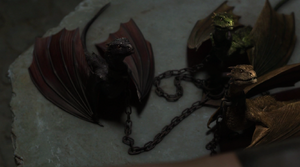
Dragons have different color patterns.
Dragons have long serpentine bodies, with proportionately long necks and tails. Their bodies have four limbs: two short back legs and two large wings as forelimbs, a body-plan similar to a bat. In later generations, after the dragons went extinct, physical descriptions of dragons became so confused in memory that artwork sometimes depicted them as having six limbs - two wings growing out of their backs in addition to four legs - but this is inaccurate. The teeth and claws of adult dragons are as long and sharp as swords.
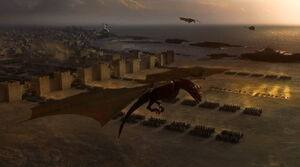
Daenerys marches forward with her army and her young dragons.
As reptiles, Dragons are covered in scales, as well as spiny horns which run down their backs from head to tail. Particularly large ridges of horns frame the edges of their faces, running along the back of the skull and along the jawline, which grow bigger as they mature. Adult dragons possess two sets of frills which run along the backs of their necks and spine, two along the sides of their necks and another two centered closer to the backbone, for a total of four frills. These are formed from webbing that grows between longer horny spines. When dragons are agitated (or simply excited), they raise and flare these frills - similar to how a furry animal like a cat will raise the hackles on its back when agitated (or a feathered animal such as a goose will puff up its feathers), in an attempt to appear bigger so as to intimidate its enemies.
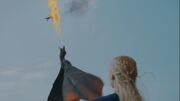
Dragons will roast their food before consumption.
Dragons are obligate carnivores, with diets consisting entirely of meat. Dragons need to roast their prey with their fire-breath before consuming it. Dragons can eat almost any kind of meat, anything from sheep to fish. Historical dragons ridden as beasts of war were known to eat fallen horses and even men on the battlefield. Fully grown dragons could swallow a live horse whole.
The scale color of dragons is highly variable, and historical dragons ranged in color from black to silver, red, gold, and even blue. Some dragons were one solid color throughout, but more often, they tend to have one primary color for most of their body, with highlights in a secondary color along their spinal crests, horns, and wing membranes. Markings observed so far include:
- Black with red markings
- Green with bronze markings
- Cream with gold markings
Fire-breath
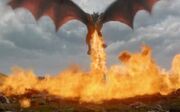
Dragon fire melts just about everything.

Small tubes in Drogon's mouth showing where they spit fire from.
Probably the most famous attribute of dragons is their ability to breathe fire. Dragonflame can turn flesh to ash, melt steel, and crack stone. Older dragons can produce more intense flame for longer durations. Dragons seem to produce their fire-breath by expelling chemicals out of two tubes in the back of their throats: when these volatile substances combine, they undergo an intense reaction which bursts into a directed jet of fire. The bodies of dragons are also very resistant to fire, particularly their own flames, which don't even damage their own mouths as they expel them. Some believe that in many ways dragons are fire, fire given form as flesh: it is said that "fire cannot kill a dragon".
Reproduction and Maturation
Like most reptiles, dragons lay clutches of eggs. Dragon eggs are roughly the size of a human child's head, and as heavy as stone, so they need to be carried with two hands. The outer shell is covered in scales, with vastly different color patterns between eggs, usually matching the color of the dragon inside. Dragon eggs are notoriously difficult to hatch, though they can maintain the spark of life inside of them for decades if not centuries. The secret key to hatching the eggs seems to involve some form of blood magic: as the House words of the Targaryens hint, it requires "fire and blood". To hatch them, dragon eggs must be burned in roaring flames, with which another creature is simultaneously being burned alive - a life in exchange for a life. In the wild this might just be a prey animal that the parent dragon kills, but human sacrifice will do the trick quite nicely, particularly if there is more than one egg to hatch.
The exact details of dragon reproduction fell out of living memory in the nearly two centuries since they died out. Several conflicting theories and rumors have been circulated, some less grounded in fact than others. It is unclear if the mother guarded eggs she had laid, or simply left them to hatch and fend for themselves, or if the father aided the mother in caring for them. Dragons were apparently relatively solitary creatures, though it is unknown if any hierarchical relationships formed within groups of dragons.
Dragons, like birds, tend to imprint on whoever is present when they hatch, regarding that person as their parent.

Drogon, already the size of a small dog.
Newly hatched dragons are about the size of a small cat, but they grow very rapidly, reaching the size of a small dog in about one year, and the size of a small pony in only three or four years. It is unknown at what age dragons reach reproductive maturity. Dragons never stop growing as long as they live, and they can live for centuries, though many died in combat before reaching such an age. The largest Targaryen dragon, Balerion the Black Dread, lived for nearly two centuries and had a skull the size of a carriage.
When dragons hatch, they do have horns around their faces and along their spines, but they are still quite small and relatively rounded. Their horns grow increasingly longer and sharper as they mature, quickly making the dragon appear more dangerous and menacing to prey or other dragons. The four lines of webbed frills along a dragon's spine only grow to a prominent size after they are about a year old.
Vocalizations
Dragons are shown to have a variety of calls, from a shrieking roar, to a low growl or hiss. They also are known to squeal.
Training and riding
Dragons cannot be truly "tamed", but they can be bonded with and trained. The Valyrians rode dragons for millennia. Aegon I Targaryen and his sister-wives, descended from Old Valyria, used the last three dragons in the world to conquer and unify the Seven Kingdoms.
Dragons are fairly intelligent animals, and like a horse or a dog, they can be trained by their rider to respond to basic voice commands.
Since they cannot be truly tamed dragons can be very dangerous, even to their riders.
History
Background
Five thousand years ago, men of the Valyrian Freehold learned how to master and ride dragons as beasts of war, and used them to forge an empire that stretched across most of the continent of Essos, dominating almost half of the Known World. Four hundred years before the War of the Five Kings, the entire Valyrian empire and almost all of its dragons were destroyed in a single day, during a cataclysmic volcanic eruption known as the Doom of Valyria. One Valyrian noble family, the Targaryens, survived the Doom on the distant island outpost of Dragonstone in the Narrow Sea - along with the last surviving Valyrian dragons.
One hundred years later, Aegon I Targaryen and his sisters used the last three surviving dragons in the world to conquer and unify the Seven Kingdoms of Westeros. For generations, the dragon-kings ruled over much of Westeros - but the dragons eventually died out after nearly a century and a half, and the species was subsequently considered to be extinct.
Season 1
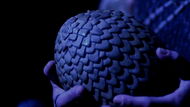
A dragon egg, used as an heirloom or item of value.
In the series the dragon species is established as having been extinct for many years. The only thing left of the race are petrified dragon eggs, which are used as decoration, and the bones which are used for weapon crafting. According to one legend, dragons originated from a second moon that hatched when it drifted too close to the sun. This is mostly dismissed as a simple myth.
They remain the sigil of House Targaryen, who were known to have a special affinity with the creatures. Even a Targaryen like Daenerys who knows nothing of her true heritage feels a connection with the relics of the ancient animals. She appears to feel a connection with the eggs; causing her to develop a curiosity about the race and the possibility that there may still be living dragons.
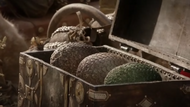
Daenerys' dragon eggs, gifted to her by Illyrio Mopatis.
Daenerys Targaryen is given three petrified dragon eggs as a gift for her wedding to Khal Drogo. The three eggs are black, green, and gold.[1]
Daenerys begins caring for the eggs and they become richer in color. She also keeps them in a chest surrounded with lit candles, day and night and is drawn to them.[2]
Arya stumbles upon the massive skull of one of the Targaryen dragons while chasing a cat in the vaults. She hides in the mouth of the skull and overhears the plotting of Illyrio and Varys.[3]
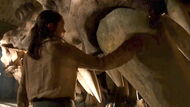
The skull of a dragon, kept in the vaults below the Red Keep of King's Landing.
Daenerys continues to experiment with her eggs. She briefly places one of the eggs into a fire pit in an attempt to hatch it, but the egg remains unhatched. She removes the egg from the fire with her bare hands, but remains unhurt.[4]
Daenerys Targaryen places the eggs on the funeral pyre of her husband after smothering him with a pillow. She also straps the witch Mirri Maz Duur to the pyre. She then lights the pyre, and walks into it, with all her followers believing her to be dead. In the morning however, she is found with three dragons, a green dragon in her arms, a black dragon clinging on her shoulder and a white-peach colored dragon clinging on her leg. A little moment later, the black dragon screeches and flaps his wings.[5]
Season 2
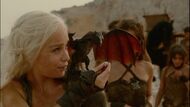
Daenerys tries to feed Drogon raw meat.
Daenerys tries unsuccessfully to feed her dragons raw meat, unsure of what she is doing wrong.[6] Later, in Qarth, she realizes that they will only eat cooked meat. She coaxes them into recognizing the Valyrian command, "Dracarys," to breathe fire, so they can cook their own food.[7]
During her stay in Qarth, word of the dragons' return begins to travel to other parts of Essos; the rumors are eventually picked up by Varys, who mentions them to Tyrion Lannister. Tyrion is more concerned with the impending Battle of the Blackwater than with newly hatched dragons on the other side of the world.[8]
The dragons are later stolen by the warlocks of Qarth and hidden in the House of the Undying.[9] The warlocks and Xaro Xhoan Daxos carry out a coup to seize control of the city in the wake of the theft. Pyat Pree invites Daenerys to come to the House of the Undying and be reunited with her 'babies'.[10]
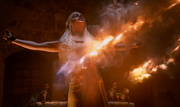
Dany's dragons breathe fire in "Valar Morghulis."
Once Daenerys is inside the citadel she is enthralled by two specific illusions; the Iron Throne room with a destroyed roof and snow falling in and the illusion of her dead husband and child. The sound of the crying dragons pulls Daenerys out of the temptation to stay in either illusion. Continuing her search for her dragons she finds them all chained beside each other, and they scream with excitement when she nears them. Daenerys goes to them, only to find herself chained as well. With her arms stretched to either side of her she becomes a captive. However with a bit of a twisted smile, Daenerys speaks the High Valyrian word for fire, and Drogon first answers her call, but isn't very effective by himself. However, both Rhaegal and Viserion then join in, setting Pyat Pree ablaze.[11]
Season 3
Daenerys arrives with her dragons in Slaver's Bay, hoping to acquire an army of Unsullied. With nothing else to pay the slave-masters, she offers them her largest dragon, Drogon, in exchange for all eight thousand of their Unsullied soldiers.[12] However, the deal is a ruse; after slave master Kraznys mo Nakloz gives her the whip signifying ownership of the Unsullied army, the dragon remains loyal to her. Revealing to everyone that she speaks Valyrian fluently, she orders her new army to slay all of the slave-masters within the city. Daenerys then commands Drogon to attack Kraznys: the slave master is consumed in a powerful jet of Drogon's fire-breath. Drogon and the other dragons then provide air support for the Unsullied as they sack Astapor, burning more of the slave-masters and their personal guards. Afterwards, Daenerys's new army triumphantly leaves Astapor marching in formation, with her three dragons flying above.[13]
When Daenerys besieges Yunkai next, she keeps her three dragons in her tent when she receives the Yunkish ambassador Razdal mo Eraz, in order to intimidate him. At one point she casually throws a piece of meat to them and they playfully fight over it, much to Razdal's consternation. Daenerys ultimately rejects Razdal's offer to leave Yunkai alone in exchange for a gift of gold, but chooses to keep the gold anyway. When Razdal's slaves attempt to retrieve it the dragons scare them away. After Razdal threatens Daenerys the dragons grew more agitated: Daenerys points out that he had threatened their "mother", and while she had promised him safe passage as an ambassador, her dragons did not. Razdal leaves in frustration.[14]
Daenerys ultimately decides not to risk endangering her young dragons again by deploying them against Yunkai, but sends in an infiltration mission consisting of Daario Naharis, Jorah Mormont, and the Unsullied commander Grey Worm. After fighting their way through the city they free the slaves and start a general uprising.[15] When the Yunkish leaders surrender and allow their two hundred thousand slaves to leave the city, they are received by Daenerys and her army as her dragons circle overhead.[16]
Season 4
Season 5
Season 6
Known Dragons
Daenerys Targaryen's dragons
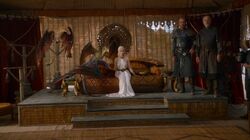
Daenerys and her Dragons.
- Drogon, named after Khal Drogo, black with red markings. Larger and more aggressive than his siblings.
- Rhaegal, named after Rhaegar Targaryen, green with bronze markings.
- Viserion, named after Viserys Targaryen, creamy white, with gold markings.
Known historical dragons
Aegon the Conqueror's dragons
- Balerion, the Black Dread, the largest dragon known, was more than 200 years old when he died. Aegon the Conqueror's steed during the War of Conquest. Allegedly the Iron Throne was forged in his breath. His skull is stored in the Red Keep.
- Meraxes, the dragon of Aegon I's sister-wife Rhaenys. His skull is stored in the Red Keep.
- Vhagar, the dragon of Aegon I's sister-wife Visenya. His skull is stored in the Red Keep.
Other dragons
- Sunfyre, Aegon II Targaryen's personal mount, to whom Aegon fed his half-sister Rhaenyra Targaryen while her son was forced to watch.[17]
- Shrykos, a dragon who lived during the Dance of the Dragons and was killed in the Storming of the Dragonpit.
- Morghul, a dragon who lived during the Dance of the Dragons and was killed in the Storming of the Dragonpit.
- Tyraxes, a dragon who lived during the Dance of the Dragons and was killed in the Storming of the Dragonpit.
- Dreamfyre, a dragon who lived during the Dance of the Dragons and was killed in the Storming of the Dragonpit.
- Syrax, a dragon who lived during the Dance of the Dragons and was killed in the Storming of the Dragonpit.
- Vermithrax, mentioned by Viserys Targaryen as the name of one of the dragons whose skull is stored in the Red Keep.[18]
- Ghiscar, mentioned by Viserys Targaryen as the name of one of the dragons whose skull is stored in the Red Keep. Apparently named after the Ghiscar region.[19]
- Valryon- mentioned by Viserys Targaryen as the name of one of the dragons whose skull is stored in the Red Keep.[19]
- Essovius- mentioned by Viserys Targaryen as the name of one of the dragons whose skull is stored in the Red Keep.[19]
- Archonei- mentioned by Viserys Targaryen as the name of one of the dragons whose skull is stored in the Red Keep.[19]
- The last dragon- mentioned by Viserys Targaryen as the last known living dragon.[19]
Quotes about dragons
- "Zaldrīzes buzdari iksos daor."
- ―(A dragon is not a slave.)
Daenerys Targaryen to Kraznys mo Nakloz, much to the shock of the latter.
Image Gallery
Behind the scenes
The dragons in the TV series are CGI creations, though in Season 2 - when they were about the size of small cats - the actors did use prop-dragon puppets on-set, to make sure that their eye-lines matched.
Supervising sound editor Tim Kimmel explained in a Season 4 interview what went into creating the dragon scream sound effects and other vocalizations: "Each dragon has multiple animals stacked and put together to create it...[in Season 3] we used the sound of two tortoises mating. There are various birds that get used in there. We sneak some other things in there—last season we had some weird dolphin sounds. I believe there's a pissed-off seal in there somewhere, during some of the angry spots. We sometimes use lions for the growlier stuff."[20]
To create the noise of dragon claws clacking against hard surfaces as they move around, the sound effects team used a combination of beef-rib bones, and also press-on nails hot-glued to gardening gloves. That way, drumming the fingers of the glove against a hard surface sounds more realistic, like a dragon's individual claws hitting a surface.[21]
In Season 5, Drogon is about 40 feet long from snout to tail-tip, and 20 percent bigger than the other two dragons (making them around 32 feet long). In Season 5, several dragon traits were copied from different real-life animals: Komodo dragons, iguanas, horned lizards, and crocodiles. Dragon physical motions were derived from eagles and bats, while for their takeoff into flight they used pelicans as a reference.[22] Joe Bauer stated that in Season 6, the dragons will double in size yet again - which would make Drogon roughly 80 feet long, and the other two around 64 feet long.[23]
In Season 5, to give the actors a better prop to react to, instead of just dangling a tennis ball and pretending it was breathing fire, the special effects team took the extra step of custom-building a fire-breathing crane. They began with a Technodolly, a motion controlled crane with a 15 foot high arm that moves in different directions while its base rolls along a track, with a teloscopic arm that usually holds a camera. The crew then took the camera out, and in its place mounted a flamethrower that could shoot as far as fifty feet. The crane was then programmed with Drogon's movements, so it could repeat the same sequence over and over again for multiple takes of the same shot. Thus the stunt team, actors, and directors always knew exactly where the dragon and its fire was supposed to be. After filming finished, digital artists then added Drogon's body around the real flames in the shot. A second method they used in Season 5 was the "SimulCam" system: a basic animation of the dragon would be saved on the camera monitor and imposed over what it was pointed at, so the cameramen and directors could always see where a dragon was supposed to be moving in any given shot.[24]
In the books
Biology
In the A Song of Ice and Fire novels, dragons are described as winged, four-limbed creatures (two legs and two wing-arms, like a bat). This form is more often described as a wyvern in medieval mythology, where dragons are typically six-limbed (four regular legs, as well as a pair of wings sprouting out of their back). As Martin and other Fantasy authors have pointed out, however, in real life physics it would actually be far more difficult for a six-limbed dragon to actually fly than a four-limbed dragon.
Dragons are very intelligent, at least as much as a dog or a horse, and at times seem to approach human intelligence and emotions, but never specifically exhibit it. They can't physically talk, and they can understand voice commands from humans, but no more than a dog or a horse can. Rather, dragons seem to have some sort of higher, unnatural level of intelligence or awareness: being magical creatures, they seem to be more in tune with "magic" - or "fate" or "nature" - than humans are, a level of awareness humans don't possess. Somehow they are often able to sense when the human rider they are bonded with needs them. Historians in Westeros frequently lamented that men could never truly understand the mind of a dragon, and sometimes dragons took certain actions for inscrutable reasons.
According to Valyrian records, dragons hatch small, about the size of an average cat, but grow larger and larger as their appetites expand. A dragon never stops growing as long as it remains fed. Dragons could live to be over 200 years old, and it is said that Balerion the Black Dread, one of Aegon I's dragons, was so huge by the time he died he could swallow an aurochs whole. Barristan explicitly states that it isn't very clear how long dragons can live before they die of natural causes, because they were bred and used as weapons of war and thus usually died of violent unnatural causes. The few healthy dragons that didn't die in combat still lived at least several centuries. Balerion may well have been the only Targaryen dragon that grew to healthy adulthood and eventually simply died from old age.
Dragons could breathe fire and were ferociously strong. However, they were also vulnerable to sustained arrow fire from the ground, to poison and to attacks from other dragons. While extremely powerful, they were not outright invincible, and given their rarity and the large expense in rearing them Aegon was reluctant to commit all of his dragons to a single battle, for fear that they might be overwhelmed through greater numbers and killed. Thus, Aegon took a calculated risk when he fielded all three of his dragons for the first and only time at the climactic Field of Fire, the battle which secured his conquest. The art of taming and commanding dragons enough to ride is almost unknown aside from a few exceedingly rare books.
A subtle joke is that dragons seem to prefer to eat sheep, though they will eat any animals smaller than themselves if they are hungry. The ancient Valyrians who first learned to ride dragons were shepherds who fed them sheep, and during the Dance of the Dragons, one wild dragon had such a fondness for sheep that the commoners whose livestock he stole named him "Sheepstealer". The girl Nettles ultimately managed to bond with Sheepstealer when she realized his preference, and brought him a new sheep every day until he grew accustomed to her presence. Similarly, at Meereen, Daenerys's dragons often attack the flocks of local shepherds (though they will also eat goats, etc.) To try to placate Drogon after he breaks loose, various animals are assembled in local fighting pits to try to keep him well-fed enough that he won't attack more humans: one pen is filled with bulls, and another filled with a wide variety of exotic animals from across the world (lions, tigers, bears, etc.) which were meant to fight in the pits - but even with this wide selection of potential meals, the dragon still prefers to go after the pen filled with sheep. This may be a reference to the real-life myth of St. George and the dragon: villages being attacked by a dragon placated the beast for a time by leaving it fresh sheep as tribute (though eventually they ran out of sheep, and had to start sacrificing young maidens). This preference for sheep wasn't an absolute rule for every dragon, however: another dragon during the Dance, called Grey Ghost, was said to have a taste for fish, and fishermen often saw him in the distance snatching his prey from the waters. Still, dragons will eat any creature smaller than themselves (cooked with their own flames first): the larger ones were known to swallow oxen and horses whole, and in the aftermath of battles feast on fallen men and their mounts alike.
Dragons, like certain species of amphibeans and fish, can shift gender and have no fixed sex: they can shift back and forth as the needs of the species require for reproduction. However, they are usually referred to as male. Only the ones confirmed to have laid eggs were generally referred to as female.
In the books, the bones of dragons are black, stated to be due to their high iron content. In the series, however, the skulls in King's Landing are shown to be white. Weapons are described as being made of this black dragon bone and the material being very valuable especially for the making of bows as it is stronger and more flexible, making the arrows fly much further. Dragon bone is also fireproof.
In the novels, Tyrion recalls from books he has read that the only certain way to kill a dragon is to pierce its eyes deep enough to puncture the brain behind them. According to Tyrion, a dragon's eyes are its only real weak spot (and not the throat or underbelly as old wives' tales claim). Only other dragons are usually strong enough to pierce another dragon's scales, with tooth and claw. Some of the younger dragons that died in the Dance, which didn't have as thick scales yet, were killed by piercing their hides but was was still very difficult.
History
The Valyrians first discovered dragons nesting in the warmth of the Fourteen Fires, the chain of volcanoes that surrounded Valyria on the south-central coast of Essos. No one kneows exactly where the species originated, however - whether they were native to Valyria, or if they originated somewhere else and later established nests there. Ancient tales say dragons once flew the skies all over the known world from Westeros to Yi Ti in the Dawn Age before the Long Night, and even a few ancient dragon skeletons have been found in such scattered locations. They might not have originated in any currently explored region of the known world. Other than Valyria, the only other potential origin site for dragons within known lands is Asshai and the surrounding Shadow Lands: dragon skeletons and petrified dragon eggs are frequently found there, and the inhabitants claim that dragons existed there since before Valyria was founded (Asshai also claims to be the oldest city in the world, but no one can confirm or deny this). Either way, the people of Asshai never succeeded in riding dragons and using them as beasts of war like the Valyrians did. At their height, during the conquest of the Rhoynar, there were at least 300 Valyrian dragons. The only dragons known to have survived were the three dragons belonging to House Targaryen, which used them to conquer the Seven Kingdoms.
The Targaryens kept their dragons in Westeros for approximately 150 years. After they died, the Targaryens kept their preserved skulls on display in the Red Keep. Tyrion states that there are nineteen skulls in all, which for a time led to the misconception that there were only ever nineteen Targaryen dragons - however, in the same chapter in which Tyrion describes them, he says that the oldest skull is three thousand years old. The oldest Targaryen dragon was Balerion, who hatched over four hundred years ago and died after living for about two centuries. Thus the nineteen skulls were never an accurate count of all Targaryen dragons, because they apparently acquired several skulls from Essos. According to later information from other short stories, there were at least 24 Targaryen dragons throughout history, though there were possibly a few more. Twenty dragons were alive during the Dance of the Dragons (of which three were hatchlings too small to ride). Several hatchlings also died young in the generations prior to the Dance, and never had dragonriders.
Most Targaryen dragons were killed in the great Targaryen civil war known as the Dance of the Dragons, which occurred 130 years after the Targaryen Conquest and 150 years before Robert's Rebellion. The short story The Princess and the Queen confirmed that twenty dragons were alive at the beginning of the Dance: Rhaenyra's faction based at Dragonstone had fourteen dragons (of which one was a hatchling), while Aegon II's faction at King's Landing had only six (of which two were hatchlings, but one of the others was the massive Vhagar). Only three dragons survived the Dance, all of them left riderless, though another one hatched late in the war.
Of Aegon's original three dragons, Balerion died in the peaceful reign of King Jaehaerys I just under a hundred years after the Conquest, Meraxes was killed in Dorne during Aegon's invasion, amd Vhagar was killed in the Dance of Dragons. The few surviving dragons after the Dance were weak and sickly, with the last dragon (a stunted creature not much bigger than a large dog) dying during the reign of Aegon III Targaryen, the Dragonbane, only 22 years after the end of the Dance. The last dragons left behind several eggs, which never hatched. These eggs were later destroyed or lost to the vagaries of history. As a result, dragons are now considered to be extinct.
See also
Dragon on A Wiki of Ice and Fire (Major spoilers from the books)
Dragon on Wikipedia
References
- ↑ Winter is Coming
- ↑ The Kingsroad
- ↑ "The Wolf and the Lion"
- ↑ A Golden Crown
- ↑ "Fire and Blood"
- ↑ "The North Remembers"
- ↑ "The Ghost of Harrenhal"
- ↑ "The Prince of Winterfell"
- ↑ "The Old Gods and the New"
- ↑ "A Man Without Honor"
- ↑ "Valar Morghulis"
- ↑ "Walk of Punishment"
- ↑ "And Now His Watch is Ended"
- ↑ "The Bear and the Maiden Fair (episode)"
- ↑ "The Rains of Castamere"
- ↑ "Mhysa"
- ↑ "And Now His Watch is Ended"
- ↑ "Cripples, Bastards and Broken Things" - This name does not appear in the books and appears to be an inside joke referring to the dragon in the film Dragonslayer.
- ↑ 19.0 19.1 19.2 19.3 19.4 "Cripples, Bastards and Broken Things"
- ↑ [1]
- ↑ [2]
- ↑ TV Guide magazine, April 9-16, 2015
- ↑ [3]
- ↑ TV Guide magazine, April 9-16, 2015
Template:Creatures


